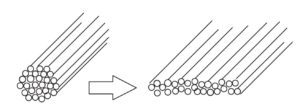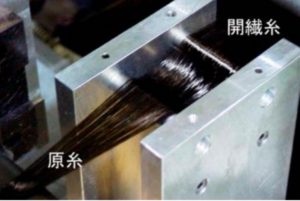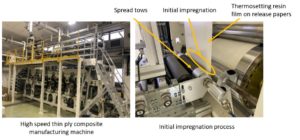New high speed thin ply composite manufacturing process
(Tow spreading image above was referred from https://www.jstage.jst.go.jp/article/fiber/64/8/64_8_P_262/_pdf)
Spread tow is one of the key technologies for composites.
Thin ply composites show effective stress transfer and avoid stress concentration, leading to initial damage of composites. The evaluation process was reviewed in a various papres.
Below is the Industrial Technology Center of Fukui Prefecture’s unique tow spreading process image for thin ply composites. Their original technologies consist of air spreading approach.
( The image above was referred from http://www2.pref.fukui.lg.jp/press/atfiles/pa2B16057465862Y.pdf )
Industrial Technology Center of Fukui Prefecture (Fukui, Japan) released new composite material (prepreg) manufacturing process.
Features are;
– Very thin ply composites < 0.05mm (0.002”)
– Process of tow spreading and resin impregnation is going on simultaneously
– Exceedingly high process speed: > 50m/min
( The image above was referred from http://www2.pref.fukui.lg.jp/press/atfiles/pa2B16057465862Y.pdf )
Dr. Kawabe of Industrial Technology Center of Fukui Prefecture adopt separate ply impregnation system.
Usually matrix resins are impregnated from one side by film, hot melt or direct application process.
But this new impregnation process is proceeded by sandwich method (upper and lower impregnation separately).
Reinforcing fibers are set upper and lower surfaces, and resin layer exists in its center.
Since the resin impregnates from near the center of the thickness toward both surfaces, high-speed resin impregnation can be realized.
The concept success above clearly comes from their total thin thickness configuration, because it is easy for resins to be impregnated to fibers.
Currently this process will be applied only for thermosetting resin systems, but Industrial Technology Center of Fukui Prefecture also has the technology for thermoplastic composite manufacturing.
They may try to apply this process to thermoplastic composites too.
As for prospective approach, sub-materials like release papers/films will NOT be necessary by more effective process design.
Non-sub-material composite manufacturing process should be high processability and cost effective, also necessary for environmental view points.
For more information (available only in Japanese) about new high speed thin composite manufacturing process:
http://www2.pref.fukui.lg.jp/press/view.php?cod=27Df2b160523081490&whence=9
* This research project is progressed in SIP (Cross-ministerial Strategic Innovation Promotion Program) of Japanese government.
Science and technology, which is being implemented by the Cabinet Office, will be carried out by promoting research and development in a unified manner, with an eye on the exit, from basic research to practical application and commercialization of important issues for people’s lives and Japan’s economic and industrial power.
A project aimed at innovation and the realization of Society 5.0.
For more information about SIP:
https://www.jst.go.jp/sip/k03/sm4i/en/outline/about.html






